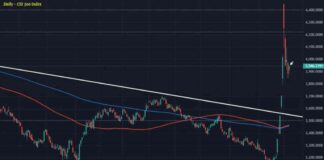Expert Analysis on the Current State of the Forex Market
The European Monetary Union (EMU) economy is facing challenging times, as indicated by the recent Flash PMI data. In September, activity contracted for the first time since February, with the headline composite index dropping to 48.9 from 51 – well below the expected 50.5. Germany and France, two major players in the EMU, saw further declines in their respective PMI readings. Germany fell deeper into contraction territory at 47.2, while France’s activity deflated from a temporary uptick during the summer due to the Olympic games, dropping to 47.4 from 53.1.
Prior to September, the EMU economy saw a sharp contraction in manufacturing, which was partially offset by growth in services. However, the manufacturing sector’s contraction has intensified, with the PMI falling to 44.8 from 45.8. While services growth remains positive overall, France saw a decline from 55.0 to 48.3, bringing it closer to a standstill at 50.5 from 52.9. S&P Global reports that the decline in overall activity is accompanied by a reduction in new orders, marking the sharpest decrease since January. This slowdown in demand has led to companies cutting back on their workforce numbers for the second consecutive month.
The key question for the market now is how the European Central Bank (ECB) will respond to these dismal PMI figures. With limited data releases between the September and October decisions, and slightly upward revisions to inflation forecasts for 2024 and 2025, the ECB seemed hesitant to accelerate the pace of rate cuts. However, the recent PMI data has prompted market speculation that the ECB may need to prioritize supporting growth, similar to the Federal Reserve. German and EMU yields initially dropped after the release but have since rebounded from their intra-day lows. EMU money markets are pricing in a 40% chance of an October ECB rate cut.
Despite the negative PMI data, EMU equities managed to reverse their post-PMI dip, with the Eurostoxx 50 index gaining 0.4%. The euro also experienced a swift decline against the US dollar, dropping from the 1.116 area to 1.1085, before recovering to around 1.113. However, underlying weakness in the US dollar remains a significant factor. Meanwhile, the British pound continues to outperform both the euro and the dollar, buoyed by better-than-expected PMI data.
In the United States, PMI figures are holding up well, with the composite index at 54.4, slightly down from 54.6. US yields saw a modest increase in response, with yields rising between 1.5 bps and 3.2 bps. However, the dollar has yet to see significant gains from the positive data.
Political Uncertainty and Market Reactions
The spread between French and German 10-year yields reached its highest level since the June snap election announcement, standing at 80 bps. Weak French PMI data, coupled with the formation of a new French cabinet over the weekend, contributed to OAT underperformance. The new cabinet, comprising conservatives and centrists with a history of discord, faces threats of a vote of no confidence from opposition blocs on both sides, potentially plunging the country into renewed political turmoil. The government coalition lacks the necessary votes to prevent such a motion, with the left-wing NFP party signaling its intention to call for a vote on October 1. The decision of the right-wing Front National to support a no-confidence bill hinges on budget considerations and Prime Minister Barnier’s approach.
In the United Kingdom, PMI figures for September showed a slight easing, with the composite gauge dropping from 53.8 to 52.9. Weaker readings in both manufacturing and services contributed to the decline, although output in both sectors increased thanks to rising customer demand and improved domestic economic conditions. Employment growth slowed to its weakest pace since June, with services seeing a marginal increase offset by job cuts in manufacturing. Rising costs, particularly in container shipping and salaries, led to an uptick in cost burdens, while prices charged rose at the slowest pace since February 2021. Despite lingering autumn budget-related uncertainty, business activity expectations remained positive.
Market Trends and Forecasts
– Intra-EMU spreads: French underperformance continues due to political uncertainty hindering budget consolidation.
– German yields: The 2-year yield is testing recent lows as markets reassess the likelihood of an ECB rate cut following weak PMI data.
– EUR/USD: The euro maintains its resilience despite the EMU economy heading into contraction territory.
– Cable: Sterling remains strong against both the euro and USD, reflecting market sentiment and economic conditions.
As the financial markets navigate through these turbulent times, investors and analysts are closely monitoring developments in the global economy and political landscape for cues on future market trends. Stay tuned for more expert insights and analysis on the evolving forex market dynamics.

















